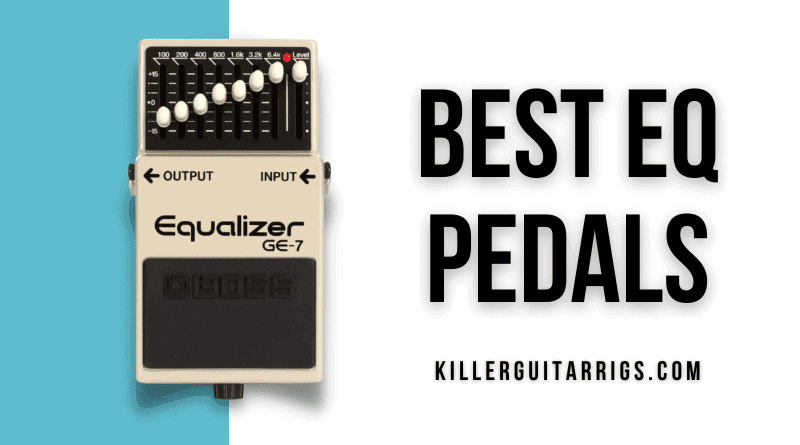EQ pedals have been around for a long time. However, they often take a back seat to other effects such as distortion, reverb, and delay. Perhaps this happens because it is not as easy to understand how EQ works, versus distortion, reverb, etc.
That said, a good EQ can have an immense impact on your sound. This is a well-known fact but may be a bit elusive for folks that have not yet gained an understanding of how equalization works.
In simple terms, an equalizer lets you raise or lower the volume on some frequency regions. For instance, raising the high band on your car stereo will produce a result, much like raising the bass frequencies. Equalizer pedals go well beyond the typical consumer EQ of high, mids, and bass, but the principle is the same.
There are plenty of models of equalizer pedals out there, in order to appeal to different needs and preferences. How do you know what to get? We’re here to help. Keep Reading.
Read more about our review process.
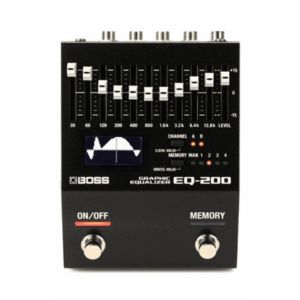
Boss EQ-200 Graphic Equalizer Pedal
Features: 4 Memory slots, Dual 10 band graphic EQ, Frequency range from 30Hz to 12.8kHz
Benefits: Tonal versatility, Excellent sound quality, Easy preset recall
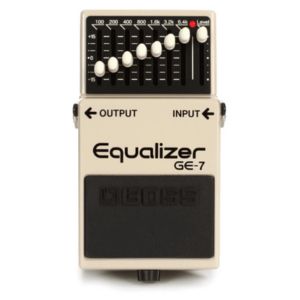
Boss GE-7 7-band EQ Pedal
Features: 7 Band graphic EQ, All metal construction, Boost/cut of +/- 15dB per band
Benefits: Consistent tone, Easy feedback reduction, Excellent durability
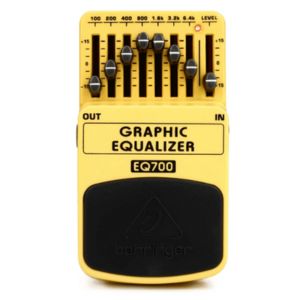
Behringer EQ700 Graphic Equalizer
Features: Status LED, Lightweight plastic housing, 7 Band graphic EQ
Benefits: Electric and acoustic compatible, Affordable price point, Easy to use
Contents
Our Top 3
The Boss GE-7 7-band EQ Pedal is our Top Pick. This is a timeless pedal that has been popular for decades thanks to its ease of use, sturdiness, and overall functionality.
The Behringer EQ700 Graphic Equalizer Pedal is our Best Budget option. This pedal offers seven bands of individual EQ controlled via sliders and is a great option for beginners that want to take greater control over their sound.
Finally, the Boss EQ-200 Graphic Equalizer is our Editor’s Choice. This powerful yet simple pedal gives the dedicated player plenty of options to sculpt tone in an intuitive way and with superior sound quality.
Individual Reviews
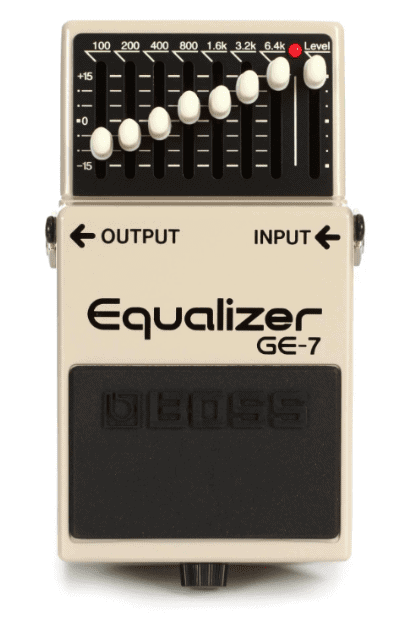
Boss GE-7 7-band EQ Pedal
One of the most popular EQ pedals for decades.
This pedal has been around for generations and is still beloved for good reason. It gets the job done in a simple and effective manner and is built like a tank. It comes with Boss' proven pedal expertise and durability.
The Boss GE-7 has been among the most popular equalizers for decades. It features a graphic equalizer that works by employing sliders for each of its seven frequencies that range from 100 to 6.4 kHz.
This pedal comes in the classical Boss stompbox-style, well-built and durable. And in typical Boss fashion, you can use it with either a 9 V battery or an adapter.
This pedal is as effective as it is simple and comes with a check indicator for the battery, and to let you know if the effect is on or not.
The specific frequencies that you can adjust are 100 Hz, 200 Hz, 400 Hz, 800 Hz, 1.6 kHz, 3.2 kHz, and 6.4 kHz. You can choose to either attenuate or boost each one with 15 dB. The last slider controls the Level of the unit.
With tested this pedal with our American Standard Strat and Fender Blues Jr amp. The overall sonic quality of the GE-7 is stellar, particularly at its price. We used this pedal to do subtle changes as well as more aggressive transformations.
Using this pedal is easy if you have a basic understanding of how frequencies work and what they do to your instrument. Simply slide the chosen frequency up or down until you reach your desired result.
We also used this pedal as a clean boost and to push our amp to overdrive. It delivered a clear tone with every change we made and the sliders gave us that smooth feeling so we wouldn’t overdo it. In short, a great pedal that has passed the test of time.
Verdict: The Boss GE-7 is one of the best-known EQ pedals ever. It comes with an intuitive graphic equalizer that lets you easily cut or boost seven frequencies, ranging from 100 to 6.4 kHz.
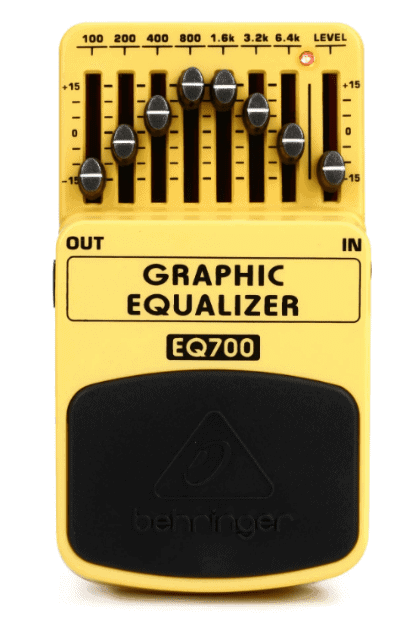
Behringer EQ700 Graphic Equalizer Pedal
A smart and comprehensive choice for beginners.
This unit offers a fantastic value for beginners that want to get their first EQ pedal. With seven bands that you can individually boost or cut, the EQ700 comes in the standard Behringer stompbox form factor.
The Behringer EQ700 Graphic Equalizer Pedal features a typical layout with a single line in, a single line out jack, and 7 EQ controls. These allow you to boost or attenuate the volume on those seven individual frequencies.
With the standard Behringer plastic enclosure, this unit also features a hinged pedal switch that comes with a thick rubber pad to make it more durable.
We started our tests by cutting out the mid-range frequencies and boosting our bass and treble just a bit. We paired this with an aggressive distortion setting on our Tube Screamer pedal for a nice metal sound with scooped mids.
We then ran some tests with no saturation to see if this pedal added any color to our sound. There was no coloration when this pedal had all its levels at 0, which is a great trait for any equalizer pedal to have.
The 7 adjustable frequencies on the EQ700 are 100 Hz, 200 Hz, 400 Hz, 600 Hz, 1.6 kHz, 3.2 kHz, and 6.4 kHz. These can be individually cut or boosted by up to 15 dB. Keep in mind that it is best to start by cutting than by boosting frequencies, especially for minor tweaks.
Aside from the seven faders for each of the frequencies, this pedal also has a master volume fader to control its overall volume. Although it can work with a 9 V battery, we opted to use an AC adaptor as it was more convenient for us.
In short, this is a fantastic pedal for the money. You can operate it as a booster, to cut back feedback, get that scooped metal sound, and plenty of other uses. A great choice for beginners as well.
Verdict: The Behringer EQ700 Graphic Equalizer Pedal comes with 7 EQ controls for maximum flexibility. This pedal does not add any color to your tone and is a great choice for beginners and folks on a tight budget.
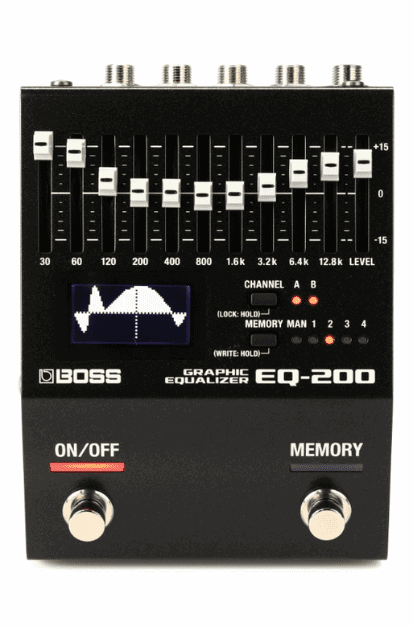
Boss EQ-200 Graphic Equalizer
Take complete control over your tone with the ultimate EQ pedal.
This EQ pedal is for discerning musicians that need to have complete control over their tone and the ability to set up in stereo. With superior functionality, sound, and features, this pedal is a must-have for pros.
The BOSS EQ-200 Graphic Equalizer features three different frequency range settings, stereo I/O, and dual EQs that can be set up for stereo, series, or parallel operation.
This pedal offers 10 bands with 15 dB of boost or cut, as well as a global level control. Additionally, you get four memory slots so you can save your own custom EQ profiles.
Being able to easily recall your custom EQ profiles is a great way to deal with sonic issues that arise in specific rooms or with specific amplifiers. You can also use this feature to create custom EQ profiles that benefit specific instruments. For instance, you can dial back some of the ice-pick highs that some Strats display.
In our tests, we went straight to a two-amp setup to try this pedal in stereo. We took advantage of this pedal’s ability to fine-tune our signal for each individual amp. All we had to do was select either channel A or B, to then dial in our desired tone.
Although it has 10 bands and plenty of features, the EQ-200 was intuitive and simple to use. It offered no coloration to our tone and gave us the ability to get really specific with our sound.
We particularly loved creating specific EQ settings and recalling them for different sounds on different songs. Another great feature is this pedal’s adjustable frequency settings that went from 30 Hz to 12.8 kHz, 32 Hz to 16 kHz, or 28 Hz to 14 kHz.
The EQ-200 also comes with a graphic display where you can monitor the EQ curve for precise adjustments. Additionally, this pedal supports external footswitches, MIDI I/O, and an expression pedal, and comes with 32-bit digital conversion with 96 kHz resolution.
In short, a superior EQ for the dedicated musician that needs the best. Built with Boss durability and quality, this unit is a great buy for discerning professionals.
Verdict: The BOSS EQ-200 Graphic Equalizer comes with three different frequency range settings, dual EQs, and 10 adjustable bands. You can also get four memory slots to create and save your own custom EQ profiles, in one of the best options on the market today.
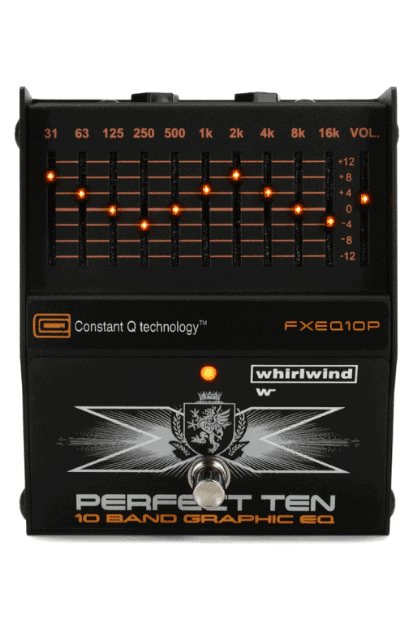
Whirlwind Perfect Ten
A unique equalizer pedal that excels in quality.
This pedal was specifically designed for the guitar by one of the most respected names in equalization. It offers pristine sound quality, smooth operation with consistent quality, and it's built like a take to withstand the rigors of the road.
The Whirlwind Perfect Ten is a graphic equalizer pedal designed by Tony Gambacurta, a well-known mastermind of equalizer design. This pedal gives you pristine sound quality with the precise controls of a standard graphic equalizer.
The Perfect Ten comes with a constant Q graphic equalizer for precision and accuracy when tone-shaping. A constant Q avoids the issue that many gyrator models face, where the EQ gets narrower once you boost or cut past a certain point, leading to phase issues.
We put this pedal to the test by trying out everything from subtle EQ changes all the way to pronounced metal scooped mids. The Perfect Ten sounded fantastic regardless of what we were going for.
Even when we tried some settings that did not make any sense from a musical standpoint, the pedal preserved the integrity of our tone and gave us exactly what we dialed in.
One of the most important facts about the Perfect Ten is that it was specifically tuned to the individual tonal nuances and dynamic aspects of the guitar signal. As the name implies, this pedal features a 10-band equalizer. It works via an 18 V power supply that ships with the unit.
In short, the Whirlwind is a great choice for musicians that want a constant Q model for extra consistency and sound quality with ten adjustable frequencies. It does have a high price tag, which may turn off folks looking for a more affordable and standard EQ.
Verdict: The Whirlwind Perfect Ten comes with fantastic sound quality, precise controls, and a constant Q for optimum operation. Built specially for the guitar by a master in the subject, this pedal is as effective as it is sturdy, and will be especially good for tone purists.
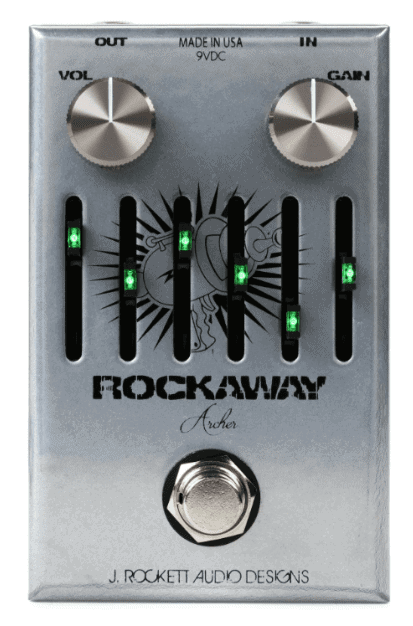
Rockett Audio Designs Rockaway Archer
A powerful and clever combination of EQ and overdrive.
A unique overdrive and EQ pedal made to the specifications of guitarist Steve Stevens. This unit is built like a tank, with a simple design, versatility and a killer look to spice up your pedalboard.
The J. Rockett Audio Designs Rockaway Archer is a 6-band EQ and overdrive pedal created specifically for renowned Billy Idol guitarist Steve Stevens. It features a durable aluminum chassis that can withstand constant gigging even under conditions of duress.
The EQ on this pedal features six green-colored bands, each for adding or cutting up to 18 dB with frequencies set at 100 Hz, 200 Hz, 400 Hz, 800 Hz, 1.6 kHz, and 3.2 kHz. Right above these six sliders, you get a Volume control for the output and a Gain control.
In our tests, we got a wide range of sounds that make this pedal a great choice for rock and blues. We started using it as a clean boost for soloing and then took it to heavy distortion that gave us a nice punch and balance.
You can think of the Rockaway Archer as a transparent overdrive. We were able to dial it in to get a good amount of gain but without really altering the tone of our guitar.
This pedal functions with a 9-volt power supply and has an internal charge pump to double its voltage to 18 volts. In short, a nice boutique pedal that lets you EQ your distortion or boost. That said, some may prefer a conventional EQ that does not come with overdrive.
Verdict: The J. Rockett Audio Designs Rockaway Archer is a unique pedal that combines overdrive and a six-band EQ. It was designed with guitarist Steve Stevens in mind and can act as a booster and take you all the way to aggressive distortion while allowing you to carefully sculpt your tone thanks to its effective EQ section.
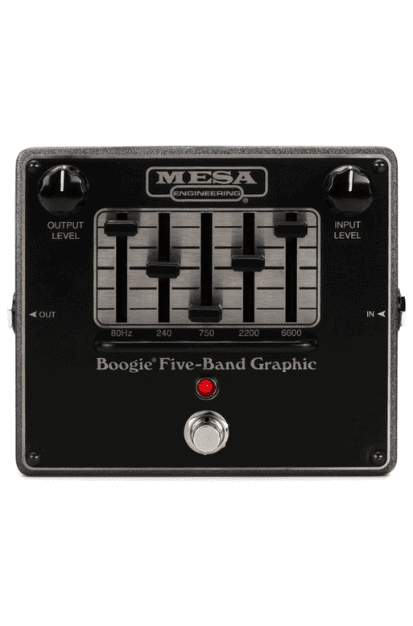
Mesa/Boogie Boogie Five-band Graphic EQ
The EQ section of legendary amps in a stompbox format.
Mesa/Boogie is one of the most respected names among guitar players. Known mostly for their fantastic amps, they also produce other great tools for guitarists, and this five band EQ pedal is further proof of that.
The Mesa/Boogie Boogie Five-band Graphic EQ pedal is based on the EQ section from the legendary amplifiers in their Mesa Boogie Mark series. This pedal offers you that same equalizer featured in these amps, and the company wanted to get it just right, going all the way to component level.
The five bands in question are 80 Hz, 240 Hz, 750 Hz, 2.2 kHz, and 6.6 kHz, which you can boost or cut by 12 dB. These five bands allow you for some versatility in your tone, and you can use this pedal for different styles and genres.
In our tests, we started by boosting the sliders for the three middle frequencies to get that scooped metal sound. The result was precisely that distinctive and punchy and hard sound that works so well for metal contexts.
We also loved how this pedal behaved in front of our Deluxe Reverb amp, giving us a fantastic signal boost that remained transparent. The fact that the Boogie Five-Band pedal comes with true-bypass switching is also a massive plus, as it preserves the integrity of your tone.
In short, this pedal features a fantastic tone while remaining versatile so you can use it in many contexts. It is quite sturdy and succeeds in recreating the EQ section of some of the most famous Mesa Boogie amps. That said, it may not be suitable for those that do not appreciate these types of amps.
Verdict: The Mesa/Boogie Boogie Five-band Graphic EQ offers you the EQ section from the Mark series amps in a pedal. You get a detailed recreation of the EQ in these amps in a well-built unit that is versatile and can last you a lifetime.
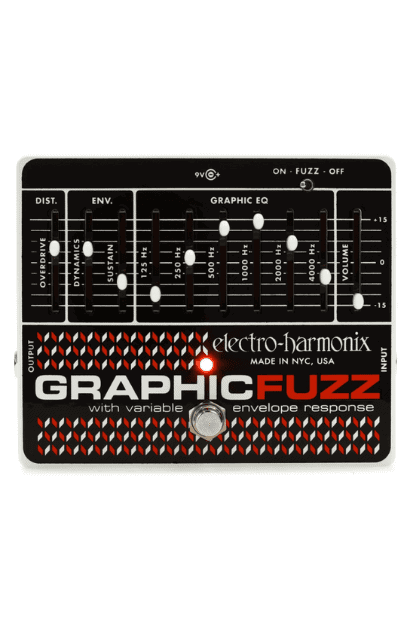
Electro-Harmonix Graphic Fuzz
A special pedal that allows you to EQ your fuzz.
Electro-Harmonix is renowned for making unique guitar pedals that have a clear identity. This is certainly the case here, as the Graphic Fuzz is an out-of-the-box take on fuzz and EQ, all bundled up in a nearly indestructible enclosure.
The Electro-Harmonix Graphic Fuzz is a well-built, compact fuzz pedal with a 6-band graphic EQ that allows you to take your tone anywhere you want to.
The six bands are 125 Hz, 250 Hz, 500 Hz, 1 kHz, 2, kHz and 4 kHz. Besides these six sliders, you also get a slider to control the distortion level, one for dynamics and one for sustain, in addition to an overall volume slider.
We put this pedal to the test by using it as it was intended: a fuzz box with EQ. We went for an aggressive fuzz and scooped the mids to get that frontal hard rock sound that has become so popular.
We then bypassed the fuzz circuit and tried this pedal as a standalone EQ, where it also performed quite well. One of the features we liked the most about the Graphic Fuzz was the Dynamic slider.
This made our guitar much more dynamic and responsive to our playing. Naturally, you get to decide how much responsiveness you want, depending on the situation at hand.
For convenience, this pedal comes with a 9.6 V DC-200 mA power adapter included. As usual for any EHX pedal, the construction is stellar and very durable.
In short, this is a great pedal that can be useful for a variety of guitarists. If you are not into fuzz, or just don’t want another fuzz box, perhaps it may be better to look elsewhere.
Verdict: The Electro-Harmonix Graphic Fuzz is a fantastic fuzz box with a 6-band graphic EQ. You can choose to bypass the fuzz circuit to use just the EQ. This pedal features a dynamic slider that brings out the nuances of the player as much as needed.
How To Choose The Right Pedal For You
EQ pedals are one of the most unappreciated tools for guitarists. They are severely underrated, especially given their ability to potentially transform your tone from mediocre to great.
A good EQ is especially good for live situations. You may be playing at a venue that enhances some frequencies over others, and a stompbox EQ can help you dial in just the right sound. The same is true for guitars, as they all respond differently in different contexts, and a decent equalizer pedal can bring them closer to the sound you have in mind.
There are a few considerations when it comes to buying an EQ. For instance, some come with more frequencies that you can control than others – there are five, six and even ten band pedals on the market.
Naturally, pedals with more sliders or faders for boosting or cutting individual frequencies allow you greater overall control of your tone. That is not to say that a five band EQ cannot greatly benefit your rig, but it does have a more limited scope.
As usual, the amount of bands and other features boils down to your own personal taste and preferences. For some folks, a ten band EQ may be a bit too much, while others may feel that anything less than that is a bit limiting.
Besides the amount of bands, another crucial point is whether the EQ is parametric or graphic. Let’s take a look at the differences.
Parametric
A parametric EQ is divided into bands, as opposed to a set frequency. Having bands, or a range between two frequencies, provides a deeper degree of control over your EQ settings.
Parametric EQs typically allow you to set the width and shape of each band, referred to as “Q”. A low Q setting produces a wide bandwidth, as it’s affecting a large range of frequencies. A high Q setting produces a narrow bandwidth and that affects a smaller range of frequencies.
Graphic
Graphic EQs come with set controls for set frequencies, and you are not able to define how wide or thin the affected area is. These types of EQs can also be effective but may be limiting for those with a very developed understanding of how frequencies work.
Most guitar equalizers are graphic, and the best ones do a great job at offering you great control over your tone. Although a bit more limited, graphic EQ pedals are typically easier to use and more affordable than parametric models.
How Does EQ Work?
This may be the most important aspect when it comes to choosing your ideal pedal. Knowing what frequencies do and how they behave is paramount to getting a good sound, not only from the pedal itself but your rig in general.
Understanding how to get rid of a “boxy sound”, how to get more “air”, or how to beef up your mids will have great results on your overall sound. All of the previous terms are related to specific frequencies – typically boxy sounds are in the 250-900 hz range, air is generally anything over 12kHz, and so on and so forth.
And just like anything guitar-related, it takes time to learn how specific ranges, bands, and frequencies work, how they relate to each other, and how they can help with much more than your guitar sound.
Final Thoughts
Equalizer pedals can significantly alter your guitar tone. From creating the popular scooped mids sound for metal to dealing with feedback and other problematic frequencies, they can do wonders for your sound.
Knowing how frequencies work is paramount to making good use of such a pedal, but we promise you it will be well worth it. This will not only help you with your guitar tone, but with your understanding of music in general.
To recap our choices, the Boss GE-7 7-band EQ Pedal is our Top Pick. It has arguably been the most popular EQ in the last decades as it offers great functionality, ease of use, and great durability.
The Behringer EQ700 Graphic Equalizer Pedal is our Best Budget option, featuring seven bands of individual EQ and no coloration to your overall tone.
Last but not least, the Boss EQ-200 Graphic Equalizer is our Editor’s Choice. This pedal is specially made for the discerning player that demands superior features, versatility, and sound quality.

